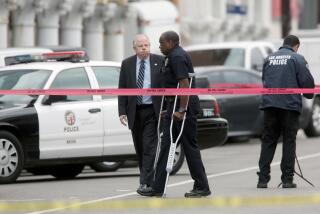Suspect Held in Officer’s 1993 Slaying
- Share via
GARDEN GROVE — All his colleagues had to go on were Garden Grove Police Officer Howard E. Dallies Jr.’s dying words, his description of the man who gunned him down: “White, male, young.”
In the more than four years since Dallies was shot during a traffic stop by a man who sped off on a motorcycle, investigators hunted down more than 3,500 leads. They enlisted help from a hypnotist, bloodhounds, a bulldozer, FBI profilers and the Marines.
On Wednesday, investigators announced that they had arrested a suspect.
Prosecutors filed murder charges against John J.C. Stephens, 26, a state prison inmate known as “the Hard Way,” a nickname hinting of a tough streak that kept him a loner on the streets.
For the investigators who now allege that he is a cop killer, Stephens’ nickname also reminds them of the long quest to capture the gunman who left Dallies bleeding in the street on March 9, 1993.
“This shooting ripped the heart out of this department,” said Lt. Kevin Raney, leader of a task force that met twice daily for the past year. “We were reeling. A phantom gunman kills an officer, and we had no idea why, how it happened, or who did it. We had to find the answers or this would keep eating at the soul of this department.”
Mary Dallies-Carpenter, the officer’s widow, struggled to keep her composure Wednesday as the arrest was announced at a news conference in front of a memorial for fallen officers. She said she was relieved, but added that the charges can’t ease her hurt.
“It won’t ever go away. It won’t ever bring Howard back. It won’t ever make it better,” she said.
Orange County Deputy Public Defender Alan J. Crivaro declined to comment Wednesday about his client, except to say that Stephens was being interviewed by police.
The suspect has been imprisoned since a December 1993 conviction for assaulting a Westminster man during a residential robbery. He also was charged with attempted murder Wednesday for the shooting of an Orange County security guard.
The investigation in the Dallies case had been so slow for so long that detectives turned to unorthodox methods, including planting an electronic bug in the suspect’s prison cell and arranging for the temporary release of a relative from a Nevada prison in hopes he would produce evidence.
In the end, the break in the case came from an acquaintance who admitted lying to investigators to protect Stephens.
For three years, the unidentified witness had maintained that Stephens was somewhere else when the 36-year-old officer was gunned down during a predawn traffic stop.
Then, befriended by a retired investigator volunteering his time to the manhunt, the witness’ story changed: The witness now says the initial statement was a lie and that Stephens came home in the early morning hours on the day of the shooting, frantic and shaking. The first thing he did was run to the bathroom sink, where he dyed his sandy blond hair a deep black, the witness told police.
“Once that alibi was removed, we had a clearer understanding of everything,” Raney said. “This investigation was a series of small steps, sometimes painfully small steps. That was one of the few big steps.”
The case against Stephens is hardly a slam-dunk, investigators concede. No weapon has been recovered, many of the people who are prepared to testify against him are criminals and there is virtually no physical evidence.
Instead, the 45,000-page filing submitted by police to prosecutors relies largely on circumstantial evidence.
“It’s been a long road,” Raney said. “Now we want to present the story of how this officer was murdered to 12 people and let them decide.”
On a crisp March morning last year, 13 men gathered on Aldgate Avenue and, with hands stuffed in pockets and heads hung down, they retraced Dallies’ last steps. They paused at the spot where the fatally wounded officer crumpled to the asphalt, his gun still holstered.
The 13 were veteran homicide detectives and undercover narcotics officers, along with one street cop and three retired investigators from the district attorney’s office.
The group was assembled at the order of Police Chief Stan Knee. Three years had passed since the shooting, and Knee wanted to restart the search for Dallies’ killer.
Knee, who keeps a framed photo of Dallies on his desk, hoped that a fresh perspective, or the promise of some new technology, might help this task force succeed where the original team had failed.
The new team reviewed all 25,000 pages compiled by the first task force, and that led to investigators focusing on three suspects--one of them Stephens.
The three names had come up repeatedly during the investigation, in phone calls from citizens, in interviews with police informants and from the hunches of patrol cops who knew the local criminal element. But there was never any concrete evidence that would clear or confirm any of them.
That became the goal of the second task force, Raney said.
Investigators described all three suspects as locals, career criminals and drug users. Police were fairly certain the killer had strong local ties.
A gray Kawasaki motorcycle the gunman was believed to have been driving was stolen--and then ditched--on nearby streets. The computer in Dallies’ patrol car indicated that the officer chased the suspect through small, residential streets--all indications that the gunman knew his way around Garden Grove.
Investigators said they came to believe that the man who killed Dallies used the same gun to wound Santa Ana security guard Rene Carpio in January 1993. Carpio described his assailant as a white man in his early 20s with light hair.
Not only had ballistics tests confirmed that the same gun was used in both shootings, but the incidents were similar in their calculated brutality, police said. The gunman in both cases fired at close range and kept shooting.
“People usually shoot to avoid capture,” Raney said. “This person was different. This was a killer.”
In their zeal to crack the case, investigators came down hard on people close to the suspects, Raney said. Grieving and frustrated, the detectives said they used strong words seeking the truth.
“Stephens’ name kept coming up, from street snitches and phone tips and citizens. We knew we had to look harder,” Raney said.
When the alibi witness for Stephens changed stories in August 1996, the reborn task force was re-energized. For the first time, Raney said, they had a breakthrough and information that directly exposed a lie by a key suspect about his whereabouts during the shooting.
Interviews with the alibi witness also produced another potentially important bit of information: The gun that killed Howard Dallies was supposedly melted to slag and buried in the backyard of a Midway City house.
Detectives got a search warrant that allowed them to dig up the yard of the house in the 15000 block of Jackson Street--but they found nothing. For two days, a city bulldozer, a team of Marine land mine specialists and volunteers sifted through 795 tons of dirt for some trace of the weapon.
“At the end we had a swimming pool-sized hole and no gun,” Raney said. “The gun is out there somewhere and we have never stopped looking for it. Finding it would be key to the whole case.”
Without the gun, investigators knew their best chance to build a case against Stephens would be his own words. Partway through a seven-year sentence in Ironwood Prison in Blythe, Stephens refused to speak to police.
Raney said the task force decided to try an almost unheard-of tactic--bugging a state prison cell.
“The challenge was to do this in a way that would not be detected,” Raney said. “Remember, these guys spend 23 hours a day in these very small areas. They know every inch and they are very aware of any change in routine.”
The scheme came to naught when one of Stephens’ fellow inmates, poking around the cell, spotted the transmitter. Frustrated investigators could only listen as their prime suspect, speaking directly into the device, muttered “Nice try.” The next sound was the device being crushed.
Without a confession, investigators pieced together a puzzle of evidence and this week Stephens was moved to Orange County to face charges in both the Dallies and Carpio shootings.
“Now, we just want justice,” Raney said. “We want closure. We want to see this end.”
More to Read
Sign up for Essential California
The most important California stories and recommendations in your inbox every morning.
You may occasionally receive promotional content from the Los Angeles Times.










